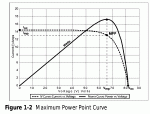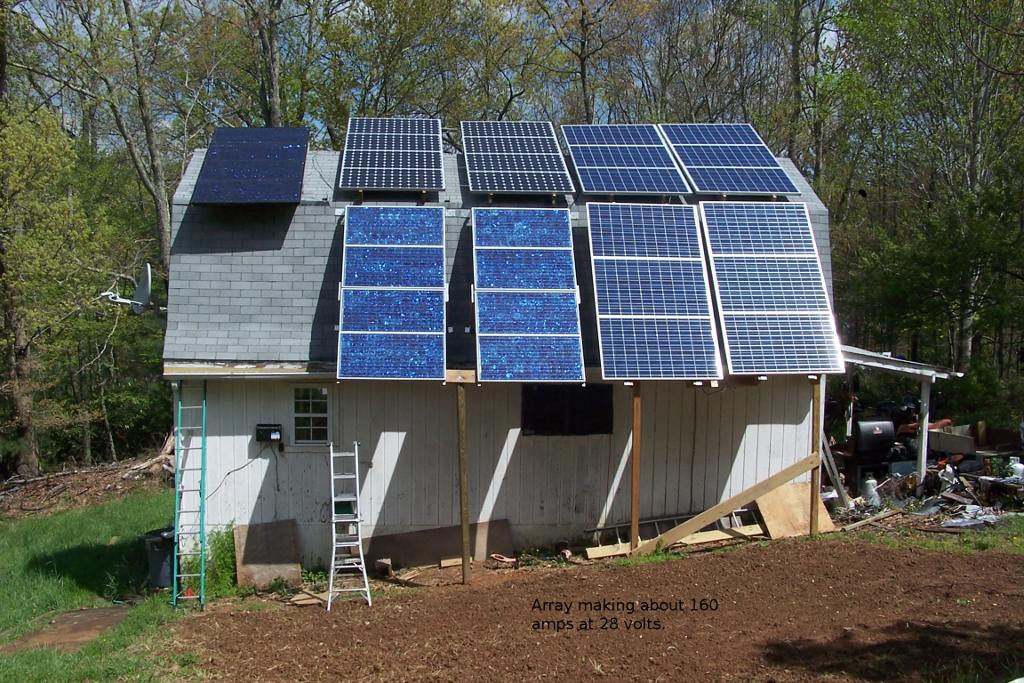Ancona is right - that was one huge project, took a couple weeks last year and a couple this year (with 2-3 people helping) - crane rent alone was about $1500. The real issue was I'm an idiot at major sky-lift construction projects, lifting things I can't lift into places I can't reach to bolt them down...
But by the last couple racks, we had that figured out and they were nearly effortless.
A lot of jobs a homesteader does are like that - you get good at it just as it's finished for good...
I'd like to give good advice on panels, but at the moment, the ones I've liked best and have been proven in real life here - are no longer made - they were BP solar. They've lived through hail the size of quarters, windstorms, you name it.
The lighter blue sparkly ones are over 30 years old and still pumping out the juice.
The big ones on the right of the pic are great, but are only a year old and I have no idea if they'll withstand all those slings and arrows - at least they were cheap (about $1/watt). They are Schott (the German glass company, but made in USA in the SW, or these were - Schott is all over the world). They are very efficient - but they had to ship me 20+ of them for me to receive 12 that weren't broken in shipping - not a great sign - the local vendor dropped the brand as a result. Could be the Germans got a little proud of their ability to make super good glass (Schott is well known for this in the physics biz) and went too thin with these. They aren't very rigid, I can say that, where with the BP ones, you might as well be holding a chunk of plywood.
Companies that have been out there "forever" - Their stuff has to be good, and people do say so - I don't have any of these myself, however.
Kyocera
Sharp
and a couple others (I'll look around more and jog my memory) - look for "Not Chinese" IMO (and all that is is opinion but I don't see a good track record from them so far). As a trader (I assume most here are) pull their financials off google finance and see if they're doing well and have been around awhile to prove it.
Avoid:
Canadian solar - they're really Chinese and dishonest as hell at the top - dilute their stock at will without warning. If management is that bad, I'd bet their warranty, quality etc can't be that much better. They are the dryships of the solar biz.
Also avoid thin film or amorphous panels, I've tried many and
all have failed, usually the company goes bankrupt just as the claims for new ones come in. Just not worth it. If a company hasn't been in business at least 5-10 years, I'd avoid them, this stuff is too expensive to be a guinea pig for them. And much of the cost isn't the panels, it's the other stuff - getting them mounted in a good spot ain't cheap or easy.
Even if you got free replacements, you don't want to have to do that over.
For a greenhouse operation you might not need the full setup, depends on your demands. A local farmer is doing this with some success. All he needs is a fan running when the sun shines and it's too hot in his greenhouse (plastic over hoops, but a huge one). We set him up with a few panels, and used a belt-drive fan with a special DC motor (not that special, but 3/4 horse at 90v nominal, permanent magnet brush motor, which is a standard thing for stuff like conveyer belt drives, they're out there cheap, surplus). This actually works pretty well - when there's less sun, the motor just spins slower - just as you want.
Back in the day, there was something even better for that for water/well pumps, I'll look around and see if they still exist. They'd drop the voltage to the motor to where the amps were high enough to keep it spinning in much lower sun insolation than a straight hookup would give (they are effectively DC to DC variable ratio transformers that harvest the most power from the panels, then deliver it to the load - a dynamic "impedance match"). For my farmer pal, it works without that, but he did buy extra panels, more than required to do his job. He's just that type of conservative.
If you want UPS power, yeah, you gotta get the batteries and solar controllers, and an inverter, which are over half the cost of a decent system. But you might not need that - I'd have to know more about your needs to give you good advice there. If you get solar controllers, look for MPPT in the specs. That's maximum power point tracking.
Panels have a voltage at which they put out best power - load them below that voltage and the current doesn't go up to match, let them get higher and they start eating their own output (the diodes are forward biased in a panel). This magic load changes with temperature and how bright the sun is - and an MPPT controller gives you 30-50% more power just when you need it most - in crummy, chilly, rainy weather. So any decent sized system is worth the extra money for that, it beats buying more panels.
FWIW, I'm using Xantrex for all the electronics now - out of almost 4 decades of using their stuff, I've only gotten one turkey (a badly designed too-cheap inverter).
Their MPPT controllers are on the pricey side, but network over a CAN bus with your inverter and have a really nice remote display/control panel that feels pretty lux, and works nicely. I'm sure there are some other brands that are good, this is just what I've wound up liking the best myself. Their sine wave inverters are totally top notch - one rated for 4kw will actually do nearly 40kw for short periods (minutes). You just can't break one. Dead short it - it shuts down in mid cycle - not even a spark.
Hook one up to 50 feet of #16 wire, shorted at the far end - the wire burns up. It's kind of nice...One of those is what the contractors used to build my shack here. They didn't think it would do, but it did. It shut down one time when one of them had a dead short in his circular saw cable - he said it wasn't that, since there wasn't the usual shower of sparks, but since he was sick and in the doctor's office, so to speak, I took his saw apart and fixed it, pushed the reset button on the inverter, and no further problems - with saws and air compressors running off it.
Here's the skinny on MPPT:

Remember, that point changes with temperature and sun insolation, else you wouldn't need the "tracking" intelligence in the thing. So, hooking panels straight up to batteries is not the way.
Edit:
Most of the time when you need it most, it's too humid here for wick/water chilling, so I didn't consider that for this lashup. I really don't need it anyway, it'd just be another thing to have to keep fixed in an unhandy location - I'm getting too old for that.
In fact, my next project is to finally finish up the rainwater collection system. Right now, I have a 40 gal tank on the downspout - which is way too small - it overflows in a few minutes of rain - and only 80 gal in a cistern for the plumbed building, also too small if I anticipate (and I do) having a woman around. I'll be buying about $1k of big stock tanks and installing those. I have a pretty nifty system now - for my water-thrifty self, but it could be better. I can drink this water all but a couple weeks out of the year, when it's pollen seasons. I sent a sample off to VA Tech to measure, and I got back "you're kidding, you just sent us distilled water, right?". It's still drinkable with the pollen, but any part out in the sun (the collection tank) grows algae like stink if you don't put in some chlorine or other algae killer...with a big enough cistern, that won't matter, I'll just dump the "polluted" stuff out. The collection tank has some nifty low-tech to it. There's a plastic window screen on a frame stretched over the top - keeps the roof-shingle rocks, leaves, etc out. There is an overflow hole near the top too, that skims off any floating junk (most of the pollen). Then, the pickup isn't quite at the bottom, so things that sink can collect there for about a once/6 month cleanout but they don't get into the plumbing. This gravity feeds into my main cistern with a valve, so I can choose when to do it. That cistern is in a crawl space, so no storage issues there - it stays not-frozen and won't grow algae.







